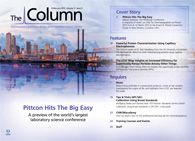Powerful Protein Characterization Using Capillary Electrophoresis
The Column spoke to Dr. Rob Haselberg from the VU University Amsterdam, The Netherlands, about his work characterizing proteins using capillary electrophoresis.
Pages 16-19
The Column spoke to Dr. Rob Haselberg from the VU University Amsterdam, The Netherlands, about his work characterizing proteins using capillary electrophoresis.
Q. What is the appeal of capillary electrophoresis coupled to mass spectrometry (CE–MS) for the characterization of protein purity and affinity? What benefits does the CE–MS approach you have developed offer over previous techniques?
A: When it comes to protein characterization, capillary electrophoresis (CE) is a very powerful technique. Protein liquid chromatography (LC) often suffers from low performance, which is related to detrimental interactions with the stationary phase and low diffusion of proteins. CE has the intrinsic capacity to produce narrow peaks for large molecules in free aqueous solution without the need for a stationary phase. Moreover, because protein electrophoretic mobility is a function of molecular charge-to-size ratio, CE may reveal small structural differences among proteins. For example, protein deamidation, glycosylation, and phosphorylation often give rise to differences in electrophoretic migration and can allow CE separation. In addition, because CE can be performed under mild, near-physiological conditions (no organic solvent needed), it permits the study of protein-ligand interactions. Binding causes shifts in ligand or protein electrophoretic mobilities that can be correlated to dissociation constants (Kds). CE uniquely enables label-free determination of the binding characteristics of individual mixture components. Combine the separation efficiency of CE with the capacity of modern high-resolution mass spectrometry (MS) to accurately determine the molecular weight of proteins, and a powerful platform for intact protein characterization is created with unprecedented performance.

Photo Credit: Michael H/Getty Images
Q. Were there any unexpected results you encountered in this research project?
A: Well, in our CE–MS work on the characterization of erythropoietin (EPO) we obtained an enormous cluster of peaks of about 20 min wide from which we could assign more than 250 protein variants. This complex mixture encompasses a single protein drug, as you would get from your pharmacist! Although I knew EPO comprised a number of glycoforms, the sheer complexity of the drug really surprised me. Another example is that we achieved highly efficient CE–MS at flow rates as low as a few nL/min. For quite some time it was believed that an appreciable flow rate (at least several tens of nL/min) was needed to facilitate electrospray ionization (ESI) in CE–MS.
Q. Do you think CE–MS will become more commonly used in the pharmaceutical industry? Do you think there are any misconceptions surrounding capillary electrophoresis generally?
A: I definitely think CE–MS will be more commonly used in (pharmaceutical) industry. We have seen an increasing interest from industrial researchers in CE–MS, particularly in the field of protein characterization. This is not limited to pharmaceutical companies; in food- and bioanalysis attention is also growing. What is remarkably unknown to a large part of the separation science community is that the CE techniques capillary gel electrophoresis (CGE) and capillary isoelectric focusing (CIEF) are already routinely used in quality control of biopharmaceuticals. Currently, there are numerous CE instruments in operation in biopharma laboratories.
I think the big misconception is that CE(–MS) is not robust. Over the last years we and several other research groups have demonstrated that with proper training and expertise, CE(–MS) performs as well as any other analytical technology. Clearly, more rigorous method validation, robustness studies, and cooperation between laboratories are still needed to convince researchers of the reliability of CE–MS technology. Recently, we participated in an interlaboratory study on CE–MS organized by the pharmaceutical industry (manuscript in preparation). Using a standardized CE–MS protocol, adequate performance was obtained in over a dozen laboratories around the world (Europe, North America, and Australia). This "round-robin" study will be published soon and we hope it will help to convince people that CE–MS is a robust technology.
Q. You have also developed low-flow sheathless capillary electrophoresis CE–MS for sensitive glycoform profiling of intact pharmaceutical proteins. What is unique about your approach and what benefits does it offer the analyst?
A: The uniqueness lies in two factors. Firstly, we work at almost zero electroosmotic flow (approximately 5 nL/min) enabling high-resolution protein separations. This enhanced separation reveals highly-similar glycoforms and allows their effective ESI. Secondly, these low flow rates provide so-called nanoelectrospray ionization conditions. These result in very high protein-ionization efficiencies and a reduction of ionization suppression by electrolytes and co-migrating species. Consequently, very high detection sensitivity is obtained. The combination of these two factors yields unprecedentedly detailed characterization of protein samples and the intact level.
Q. Could low-flow sheathless capillary electrophoresis be used for any other applications?
A: Definitely. Sheathless CE–MS at low flow conditions, but also using higher electroosmotic flows, has already shown high potential for peptide mapping, metabolic profiling, low-molecular-weight drug analysis, and several other applications. Over recent years, several research groups have explored these possibilities and I feel we are just at the start of many more applications.
Q. What other projects involving CE are you working on?
A: We believe that CE(–MS) can be very valuable in many more instances, and currently several of our projects aim at developing new technology and applications in this field. We are working on the combination of CE with surface-plasmon resonance (SPR) detection developing new cell designs. In another project, we try to solve the incompatibility of CGE and MS detection. We are also working on new CE–MS methods for the characterization of monoclonal antibodies (mAbs) and antibody-drug conjugates (ADCs). Our laboratory develops strategies to couple affinity CE with MS to achieve the simultaneous assessment of protein heterogeneity and interaction. Moreover, we study binding and aggregation of cyclodextrins by CE(–MS) and develop chiral CE–MS methods for the enantioselective analysis of amino acids in biofluids (manuscripts in preparation).
Q. How do you aim to promote the positive attributes of CE?
A: When people are interested in CE and/or CE–MS and want to know what it can bring for them and their applications, I would be happy to discuss with them and explore possibilities and potential collaborations. We have the technology and knowledge, and are always open for real-life applications.
Our group also actively participates in national and international conferences. There are actually two CE-related conferences coming up soon; Analytical Technologies Europe in Berlin (17–20 March) and MicroScale Bioseparations in Shanghai (26–29 April). Later in the year there will also be ITP in Helsinki and CE Pharm in New York.
Moreover, via LinkedIn I am also a member of analytical and CE-related discussion groups, like the International group of Capillary Electrophoresis and CE Pharm Conference.
Rob Haselberg obtained his doctorate at Utrecht University on the development and application of CE–MS technologies for the analysis of biopharmaceuticals. Subsequent post-doctoral research performed at Utrecht University and VU University focused on developing novel CE(–MS) approaches to study protein heterogeneity and affinity. In 2013, Rob was appointed to the Division of BioAnalytical Chemistry of the VU University where his research focuses on the characterization of (intact) biomacromolecular compounds. Moreover, he supervises the CE and CE–MS facility of the group.

Rob Haselberg
E-mail: r.haselberg@vu.nl
Website: http://www.chem.vu.nl/en/research/division-bioanalytical-chemistry
This article is from The Column. The full issue can be found here>>

Common Challenges in Nitrosamine Analysis: An LCGC International Peer Exchange
April 15th 2025A recent roundtable discussion featuring Aloka Srinivasan of Raaha, Mayank Bhanti of the United States Pharmacopeia (USP), and Amber Burch of Purisys discussed the challenges surrounding nitrosamine analysis in pharmaceuticals.
Silvia Radenkovic on Building Connections in the Scientific Community
April 11th 2025In the second part of our conversation with Silvia Radenkovic, she shares insights into her involvement in scientific organizations and offers advice for young scientists looking to engage more in scientific organizations.
Regulatory Deadlines and Supply Chain Challenges Take Center Stage in Nitrosamine Discussion
April 10th 2025During an LCGC International peer exchange, Aloka Srinivasan, Mayank Bhanti, and Amber Burch discussed the regulatory deadlines and supply chain challenges that come with nitrosamine analysis.
Silvia Radenkovic on Her Research and Passion for Scientific Collaboration
April 3rd 2025Silvia Radenkovic is a laboratory clinical biochemical genetics fellow at UMC Utrecht, the Netherlands and a member of Females in Mass Spectrometry (FeMS). She is currently doing a clinical fellowship where she is involved in diagnosing and helping treat patients with inborn metabolic diseases (IMD). Her research focuses on IMD such as congenital disorders of glycosylation (CDG), omics techniques such as tracer metabolomics, and different disease models.










